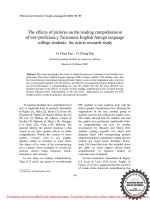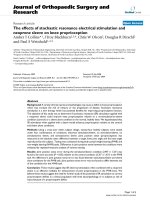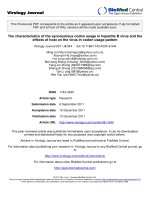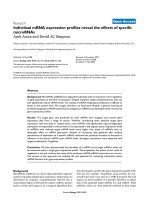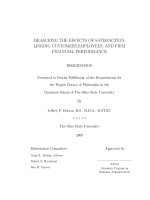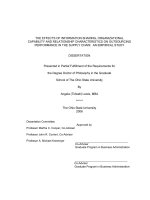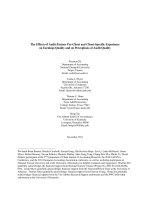Research on the effects of sulfur on characteristics of sulfur bituminous binder (SBB) and hot mix asphalt – sulfur (HMAS)
Bạn đang xem bản rút gọn của tài liệu. Xem và tải ngay bản đầy đủ của tài liệu tại đây (820.04 KB, 13 trang )
<span class='text_page_counter'>(1)</span><div class='page_container' data-page=1>
<b>Transport and Communications Science Journal </b>
<b>RESEARCH ON THE EFFECTS OF SULFUR ON </b>
<b>CHARACTERISTICS OF SULFUR BITUMINOUS BINDER (SBB) </b>
<b>AND HOT MIX ASPHALT – SULFUR (HMAS) </b>
<b>Nguyen Thu Trang1*, Tran Ngoc Hung1, Pham Huy Khang2, </b>
<b>Bui Xuan Cay2, Bui Ngoc Kien3 </b>
1<sub>University of Transport Technology, No 54 Trieu Khuc Street, Thanh Xuan, Hanoi, Vietnam </sub>
2<sub>University of Transport and Communications, No 3 Cau Giay Street, Hanoi, Vietnam </sub>
3<sub>Thuyloi University, No175, Tay Son, Dong Da, Ha Noi, Viet Nam </sub>
ARTICLE INFO
TYPE: Research Article
Received: 5/10/2020
Revised: 30/10/2020
Accepted: 6/11/2020
Published online: 25/01/2021
<i> </i>
<i>*<sub> Corresponding author </sub></i>
Email: ;
</div>
<span class='text_page_counter'>(2)</span><div class='page_container' data-page=2>
<b>1. INTRODUCTION </b>
Recently, the use of sulfur to improve or replace asphalt in asphalt concrete has been
successfully and it was proven both in laboratory experiments as well as in actual
construction. The available advantages and low cost of sulfur created the opportunity to
reduce the cost of pavement materials up to 21% [1]. On the other hand, since the end of
2003, sulfur as a by-product of petrochemical refining has increased the deterioration of air
quality and regulations for air quality control had become more stringent. Products from the
oil industry had to comply with low sulphur content thereby increased the attractiveness in
using for sulfur in road applications [2]. By the time, Shell Corporation has developed and
used sulfur for asphalt concrete which called Thiopave. Thiopave has been used in many
countries such as USA, China, India, Qatar, Canada, China [2-7]. Many studies related to
sulfur in asphalt concrete have been conducted to investigate its properties, evaluate its
performance and ability of highway construction application. Previous researches indicated
that sulfur created the increase of Marshall stability of sulfur asphalt concrete mixtures and its
stiffness increases with time, which increased the resistance of wheel rutting of flexible
pavement structures. The stiffness modulus was increased for a series of mixtures as well as
energy savings, i.e. bitumen saving, energy savings during production, and possibly pavement
thickness reduction or longer pavement life [2-7].
According to Strickland et al. 2007 [8], the results of mixed and compacted specimens
indicated that it usually takes several days for an asphalt mixture made with sulfur to develop
its final strength due to the progressive restructuring of the modified sulfur in the mixture.
This curing period is not a problem on the road because the sulfur modified mixture generally
has a higher initial stiffness than conventional asphalt.
In Vietnam, sulfur is a by-product of the oil and gas production process of Dung Quat oil
refinery with an output of 18 tons per day. This output is expected to increase in the future
and in other refineries produce. This study investigated some properties of SBB and HMAS
according to the sulfur / bitumen ratio using materials in Vietnamese conditions and the
variation of these properties of SBB, HMAS in different time to determine the appropriate
time for sample maintenance before testing the mechanical properties.
<b>2.</b> <b>MATERIALS AND EXPERIMENTAL METHODOLOGY </b>
<b>2.1. Materials Preparation </b>
<b>2.1.1. Materials </b>
<i>2.1.1.1. Bitumen </i>
</div>
<span class='text_page_counter'>(3)</span><div class='page_container' data-page=3>
Figure. 1. Sulfur byproduct from Vietnam.
</div>
<span class='text_page_counter'>(4)</span><div class='page_container' data-page=4>
Table 1. Physical properties of conventional binder 60/70.
<b>Properties of bitumen </b> <b>Unit </b> <b>Results </b>
Softening Point, ASTM D 36 Standard oC 48.3
Ductility, 25 °C, ASTM D 113 Standard cm >100
Penetration 25 °C, ASTM D5 Standard 0.1mm 62
Flash point, ASTM D 92 Standard o<sub>C </sub> <sub>276 </sub>
Loss on Heating of 163oC in 5 hours ASTM D6 Standard % 0.045
Ratio of penetration at 163o<sub>C on penetration at 25</sub>o<sub>C ASTM D5 </sub>
Standard % 60.0
Solubility of bitumen in Trichloroethylene AASHTO T44
Standard % 99.83
Density g/cm3 1.035
Viscosity at 60°C, ASTM D4402 Pa.s 279.642
<i>2.1.1.2. Sulfur </i>
Sulfur in this paper was a byproduct Dung Quat Oil Refinery which is produced at Binh
Son Refining and Petrochemical Company Limited (BSR) in Vietnam with an analytical
reagent more than 99% purity as shown in Figure 1. In the temperature Sulfur has crystalline
with the round form of 2-3 mm diameter Figure 1 and density of 2,063 g/cm3. X-ray
diffraction (XRD) spectra was used to specify feature of Sulfur at the room temperature. The
XRD result of Sulfur in this paper has shown in the Figure 2.
<i>2.1.1.3. Aggregate </i>
Coarse and fine aggregate were bazan from Phu Man Quarry in Thanh Oai, Ha Noi and
were fully crushed. Filler was limestone from Kien Khe in Ha Nam.
HMAS and HMA were using the same 12,5 mm aggregate gradation (Figure 3).
Figure 3. Design Aggregate Gradation Curve.
<b>2.1.2. Sample Preparation </b>
<i>2.1.2.1. Sulfur bitumen binder (SBB) </i>
</div>
<span class='text_page_counter'>(5)</span><div class='page_container' data-page=5>
melts and diffuses evenly in the mixture. The stirring time is 5 minutes, and during mixing,
always maintain the temperature of 1350C. Sulfur was added in the bitumen with the ratio of
10/90; 20/80, 30/70 and 30/60 by weight as named SBB1 (S/B ratio = 10/90); SBB2 (S/B
ratio = 20/80); SBB3 (S/B ratio = 30/70); SBB4 (S/B ratio = 40/60). Samples after mixing are
poured into molds and cured at room temperature. A bitumen sample 60/70 without sulfur
was simultaneously prepared in this research as a reference sample. The results presented in
this study were the mean values of six measurements.
<i>2.1.2.2. Preparation of hot mix asphalt sulfur (HMAS) </i>
For this study, a mix design was conducted for each of the control and HMAS with mass
sulfur percentages 30%, 40% using the Marshall Method according to with VietNamese
Standard Test Method TCVN 8820-2011 (Standard Practice for Asphalt Concrete Mix Design
Using Marshall Method) and Decision 858/QĐ-BGTVT, 2014.
Figure 4. Viscosity - temperature diagram of SBB samples.
For three mixes, the optimum binder content was determined corresponding to 4,5 ÷5
percent air voids (Recommended by Decision 858).
For each HMAS, the content of SBB was determined according to Equation 1.
100
(%)
100 <i>s</i>( <i>bitum</i>)
<i>AR</i>
<i>SBB</i>
<i>R</i> <i>P R G</i>
=
− − (1)
Where:
A = weight percentage of binder in conventional mix design, %;
R = Gsulfur/Gbitum (R = 1,99 for this study);
Ps = weight percentage of Sulfur in SBB, %;
Gbitum = specific gravity of the bitumen, 1,035g/cm3;
Gsulfur = specific gravity of the bitumen, 2,067g/cm3.
</div>
<span class='text_page_counter'>(6)</span><div class='page_container' data-page=6>
Table 2. Range of mixing and compaction temperature of SBB concrete samples.
<b>No. </b> <b>Binder Type </b> <b>Mixing Temp., (o<sub>C) </sub></b> <b><sub>Compaction., (</sub>o<sub>C) </sub></b>
<b>1 </b> Bitumen 60/70 (S/B = 0/100) 147 ÷151 137 ÷ 141
<b>2 </b> SBB_30/70 (S/B = 30/70) 128 ÷ 133 118 ÷ 122
<b>3 </b> SBB_40/60 (S/B = 40/60) 126 ÷ 131 116 ÷ 120
To mix the HMAS samples in the laboratory, the aggregate is heated at 135°C for 12
hours. Parallel to the aggregate heating process, mixing SBB mixture with S/B ratio was
prepared according to 2.1.2.1. When the aggregate meets the temperature, the process of "dry
mixing" the aggregate with mineral powder is carried out for 30 seconds in a mixing tank
heated to 135oC. The "wet mixing" process with SBB binder is then carried out in 60
seconds, ensuring a homogeneous mixture. All the samples HMAS were short-term aged in
the oven at a temperature of 125oC for 2 hours before compaction. The reference HMA
mixture was mixed at 155°C and compacted at 145°C.
<b>2.2. Experimental Methodology </b>
<b>2.2.1. Penetration Testing </b>
The penetration test is used to characterizes consistency of bitumen. Higher values of
penetration indicate softer consistency. The testing apparatus was setup as in Figure . For the
penetration test, a 100 g needle penetrated into a bitumen sample for 5 s at 25 °C, according to
the ASTM D 5 Standard. The penetration of bitumen and SBB was determined according to
ASTM D5 / D5M - 19a at the age of 0, 7, 14, 30 days.
Figure 5. Penetration test.
<b>2.2.2. Softening Point testing </b>
</div>
<span class='text_page_counter'>(7)</span><div class='page_container' data-page=7>
when bitumen softens and deforms. This is one of the factors in predicting the meltability of
bitumen materials when temperatures rise. The softening temperature of bitumen is
determined by the Ring and Ball Apparatus as shown in Fig. 5. The softening point of
reference bitemen and SBB was investigated at 0, 7, 14 and 30 days.
Figure 6. Softening Point testing apparatus.
<b>2.2.3. Marshall testing </b>
The Marshall test according to ASTM D6927 with Daiwa apparatus (Fig.6) determines
Marshall stability and Flow.
Figure 7. Marshall testing apparatus.
</div>
<span class='text_page_counter'>(8)</span><div class='page_container' data-page=8>
curing at room temperature. After periods of 1,7,14,21 and 28 days, samples were tested to
determine Marshall stability and Flow.
<b>3.</b> <b>Results and discussion </b>
<b>3.1.</b> <b>Penetration of SBB </b>
The results on average depth of 06 samples per penetration test of SBB binder samples
are shown in Table 3 and Fig. 8. Experimental results were evaluated for precision according
to standards ASTM D5 /D5M - 19a.
Table 3. Results of tests on penetration depth of SBB samples by date of age.
Figure 8. Variation in penetration of SBB samples with age.
</div>
<span class='text_page_counter'>(9)</span><div class='page_container' data-page=9>
precision of the penetration test show that not all results are pass.This might be because when
the bitumen and sulfur was combined, a part of the sulphur is either dissolved or chemically
combined with the bitumen. The un-dissolved quantity of sulfur in the bitumen remains
predominantly as free sulfur and it crystaled during cooling, settled, unevenly distributed in
the sample, this created an inhomogeneous binder. In that case, the measured penetration
value normally was not reproducible and depended on the existence of sulfur crystals at or
near the penetration needle.
The analysis of ANOVA variance with 95% confidence level, Tukey's family error rate
5% shows a significant effect of time to the penetration value of SEA samples at 25°C. For
samples SBB 10/90 and SBB 20/80, sharp decrease in penetration occurred at times of 0, 7
and 14 days. After 30 days, penetration of SBB 10/90 and SBB 20/80 samples did not differ
statistically compared to 14 days of age. For the SBB 30/70 and SBB 40/60 samples,
however, the penetration still decreased significantly after 14 days.
The rule of varying the penetration of SBB samples with different sulfur content over the
days is explained by the crystallization of sulfur by the time [9, 10, 11]. The penetration of
SBB decreased show that the stiffness of the SBB mixture was seen to increase with time.
These studies to explain the increase stiffness of asphalt pavements containing SBB.
<b>3.2. Softening point of SBB </b>
Experimental results on average softening temperatures of 06 samples of SBB binder are
shown in Table 4 and Fig 9. Experimental results were evaluated for precision according to
standards ASTM D36.
The results show that the softening temperature of SBB samples with different S/B ratios
at 0 day of age decreases in comparison with the original 60/70 asphalt sample. But the
softening temperature tends to increase with sulfur ratio and age of sample. The softening
temperature increased most significantly after 14 days.
</div>
<span class='text_page_counter'>(10)</span><div class='page_container' data-page=10>
Figure 9. The softening temperatures of SBB samples by date of age.
The analysis of ANOVA variance on softening temperatures of SBB samples with the
confidence level 95% and Tukey's family error rate 5% shows a significant influence of time
on the softening temperature values of SBB samples. For SBB samples 10/90, after 7 days ,
there was insignificant increase in softening temperature and there was no change in softening
temperature at 7, 14, 30 days of age. The softening temperature of the SBB sample 10/90 after
30 days is equivalent to the 60/70 bitumen sample. For SBB samples of 20/80 and 30/70
softening temperatures increased after 7, 14 days of curing, higher than bitumen 60/70. The
analysis also shows that there was no statistical difference between 30-day and 14-day
samples in the softening temperature of SBB 20/80 and SBB 30/70 samples. In particular, for
40/60 SBB samples, the softening temperature increased substantially after 7, 14 and 30 days.
After 14 days, the SBB 20/80, 30/70, and 40/60 samples have the softening temperatures
increased 1.11-1.16 time (4.5oC-6.8o C) compared to the 60/70 bitumen sample.
The tendency to increase the softening temperature of SBB samples signifies the ability
to increase the Marshall stability and to reduce the rutting in asphalt samples using SBB.
Specifically, as increasing the softening temperature of bitumen by 5oC the Marshall stability
would increase by more than 1.3kN, and the incremental rut depth would decrease by half
[12].
<b>3.2.3. Marshall Testing </b>
Experimental results to determine the optimal binder content for the HMA and HMAS
are shown in Table 5.
Table 5. Optimal binder content in asphalt concrete mixtures.
<b>Asphalt </b>
<b>Concrete </b> <b>Binder Type </b>
<b>Optimal binder content, % </b>
<b> </b> <b>Original </b>
<b>bitumen </b> <b>Sulfur </b>
<b>HMA </b> Bitumen 60/70 4,5 4,5 0
</div>
<span class='text_page_counter'>(11)</span><div class='page_container' data-page=11>
These results show that optimum binder content increased with increasing sulfur
content in the mixture. The test results of the Marshall properties shown in Fig.10; Fig. 11.
Figure 10. Marshall Stability of HMAS by date of age.
Figure 11. Marshall Flow of HMAS by date of age.
Marshall stability of HMAS_30/70 and HMAS_40/60 samples after 28 days was 20% to
33% higher than HMA. The Marshall flow of HMAS after 28 days was 17% to 23% lower
than that of HMA.
Investigation of changes in the Marshall properties of HMAS by time showed that
Marshall stability of HMAS samples increased significantly during the first 14 days after
preparation and increased slightly from 14 to 28 days. The law of reduction in Marshall Flow
over time is similar: a rapid decrease during the first 14 days and gradually stabilize from 14
to 28 days.
</div>
<span class='text_page_counter'>(12)</span><div class='page_container' data-page=12>
days. After 14 days, the Marshall stability value continued to have an increase, but was not
statistically significant. Marshall Flow of sample HMAS decreased gradually by the time and
stabilized after 14 days. By the time, the crystallization of sulfur in the structure of HMA
leading to increased stiffness and reduced deformation under the effect of external forces.
<b>4. CONCLUSION </b>
- Sulfur is a byproduct of petrochemical plants in Vietnam can be used in combination
with bitumen to produce asphalt concrete.
- HMAS has a lower mixing and compaction temperature than conventional HMA from
20oC to 25oC (mix at 135oC and compact at 125oC).
- By the time, sulfur crystals formed in the HMAS structure significantly improved
Marshall stability. Marshall stability of HMAS is higher than conventional HMA from 20% to
33% (depending on the amount of sulfur used), the Marshall Flow of HMAS is lower than
conventional HMA from 17% to 23%). Marshall parameters did not change significantly at
21, 28 days of age, showing that the crystallization of sulfur took place rapidly at the first 14
days after compaction and stabilization.
- Experimental program indicated that SBB concrete samples showed the significant
performance of Marshall stability, which recommended that the age for evaluation of
Marshall stability of SBB concrete mixtures should be after 14 days.
<b>REFERENCES </b>
[1].M. G. Baig et al., Investigation of sulfur modified asphalt concrete mixes for road construction in
the gulf, Efficient Transportation and Pavement Systems – Al-Qadi, Sayed, Alnuaimi & Masad (eds),
Taylor & Francis Group, London, ISBN 978-0-415-48979-9, 2009.
[2]. J. C. Nicholls, Review of shell thiopave sulfur - extended asphalt modifier, TRL Report TRL672,
2009.
[3]. Federal Highway Administration, An Alternative Asphalt Binder, Sulfur Extended Asphalt (SEA),
FHWA-HIF-12-037, 2012.
[4]. D. Timm et al., Evaluation Of Mixture Performance and Structural Capacity of Pavements Using Shell
Thiopave, Report No. NCAT 09-05, 2009.
/>
[5]. V.A. Gladkikh et al., Eco–friendly high-performance pavement materials, IIOABJ, 2016, pp.
453-458. />
[6]. M. Al-Mehthel et al., Sulfur extended asphalt as a major outlet for sulfur that outperformed other
asphalt mixes in the Gulf, The Sulphur Institute’s (TSI) Sulphur World Symposium, in Doha, Qatar,
2010, pp. 12-15. />
[7]. J.P. Mahoney et al., Sulfur Extended Asphalt Laboratory Investigation - Mixture Characterization,
Report No WA-RD 53.2, 1982. />
</div>
<span class='text_page_counter'>(13)</span><div class='page_container' data-page=13>
/>
[9]. A. M. O. Mohamed, M. M. El Gamal, Sulfur concrete for the construction industry, UAE
University, Al Ain, United Arab Emirates, 2010.
[10]. I. Gawel, Chapter 19 Sulphur-Modified Asphalts, Developments in Petroleum Science, 40 (2000)
515-535.
[11]. R. Djimаsbе et al., Research of the technology for the production of modified sulfur bituminous
binders, 2018.
</div>
<!--links-->
<a href=' /><a href=' /><a href=' /><a href=' /><a href=' />

